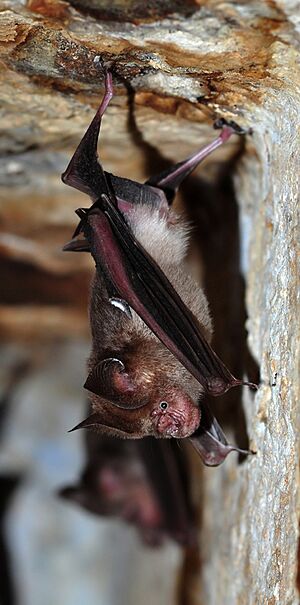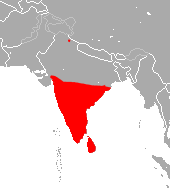Schneider's leaf-nosed bat facts for kids
Quick facts for kids Schneider's leaf-nosed bat |
|
|---|---|
 |
|
| Profile | |
| Conservation status | |
| Scientific classification | |
| Genus: |
Hipposideros
|
| Species: |
speoris
|
 |
|
| Schneider's leaf-nosed bat range | |
| Synonyms | |
|
Vespertilio speoris |
|
Schneider's leaf-nosed bat, also known as Schneider's roundleaf bat (Hipposideros speoris), is a type of bat. It belongs to the family Hipposideridae. This bat lives only in South Asia. You can find it in dry forests, caves, and even in cities.
Contents
About Its Name
This bat was named after Johann Gottlob Schneider. He was a German expert in old languages and a naturalist. He first saw and described this bat in 1800.
What Does It Look Like?
This is a small bat. It has a special "leaf-nose" with three extra small flaps. The outer flap is smaller than the other two. It also has well-developed flaps next to its nostrils. These features help tell it apart from other bats in the Hipposideros family. There's also a small sac above its leaf-nose.
H. speoris bats can be gray or orange-brown. They are lightest between their shoulders and on their belly. Their sides and back are darker.
Bat Life and Habits
Reproduction and Young Bats
Female bats are pregnant for about 135 to 140 days. After this time, they give birth to one baby bat. Newborn bats have their eyes closed and their ears folded. They are born without fur. Their back is dark, and their belly is pink.
After one week, their eyes start to open. Their eyes are fully open after two weeks. Their ears begin to move around ten days after birth. When the bats are about one month old, their fur is as thick as an adult's. However, it is a darker color.
Young bats hold onto their mothers upside down while they drink milk. Most mothers carry their newborns when they fly out of the cave to find food. But once the babies are older than 7 days, mothers often leave them inside the cave. Mothers come back regularly before midnight to get their young.
When a mother gets her baby, she moves towards it. She gently touches it with her forearm. Then she shows her belly. When the baby tries to hold on, the mother turns her body. She spreads her wing membranes a little. This helps the baby hold on and let go of the rock. Then the baby moves to drink milk. After drinking, it stretches its wings. Mothers seem to spend most of the night inside the cave.
What Do They Eat?
This bat usually flies slowly, close to the ground. It hunts for insects while flying. It prefers to hunt in areas with plants and trees next to open spaces. Its diet mostly includes beetles, flies, mosquitoes, and other insects.
How Do They Find Things?
Schneider's leaf-nosed bats use echolocation to find their way and hunt. This means they send out sounds and listen for the echoes. The echoes tell them where objects or prey are. Their echolocation sounds are short and have a high repetition rate. These bats use a special type of sound that helps them navigate.
Where Do They Live?
You can find this bat in India. It lives in many states there, like Andhra Pradesh and Tamil Nadu. It also lives in Sri Lanka. Recently, it was also seen in Pyay, Myanmar. These bats can live at high places, up to about 1,285 meters (4,216 feet) above sea level.
This bat is common and found across its whole range. They often roost, or rest, in groups of up to 1,000 bats.
They like to roost in caves, underground cellars, old forts, palaces, and under bridges. They also use old buildings, temples, and tunnels. These places can be in dry plains or on forested hillsides. In India, the bats are more spread out in their roosts. But in Sri Lanka, they roost very close together.
Protecting These Bats
The IUCN (International Union for Conservation of Nature) lists this species as "least concern." This means they are not in danger of disappearing. They live in many places and can adapt to different habitats. Their population is large, and it is not decreasing quickly.
However, in some parts of India, these bats face local threats. People sometimes disturb their roosts because of tourism. Stone quarrying and new building projects can also destroy their homes. In some areas, people disturb them for other reasons. For example, in Karnataka and Kerala, human activities can disturb the bats. In Maharashtra, tourism and other human activities cause problems. No threats have been found for the bat populations in Sri Lanka.
There are no specific plans to protect this species right now. But the bat has been seen in some protected areas across its range.



